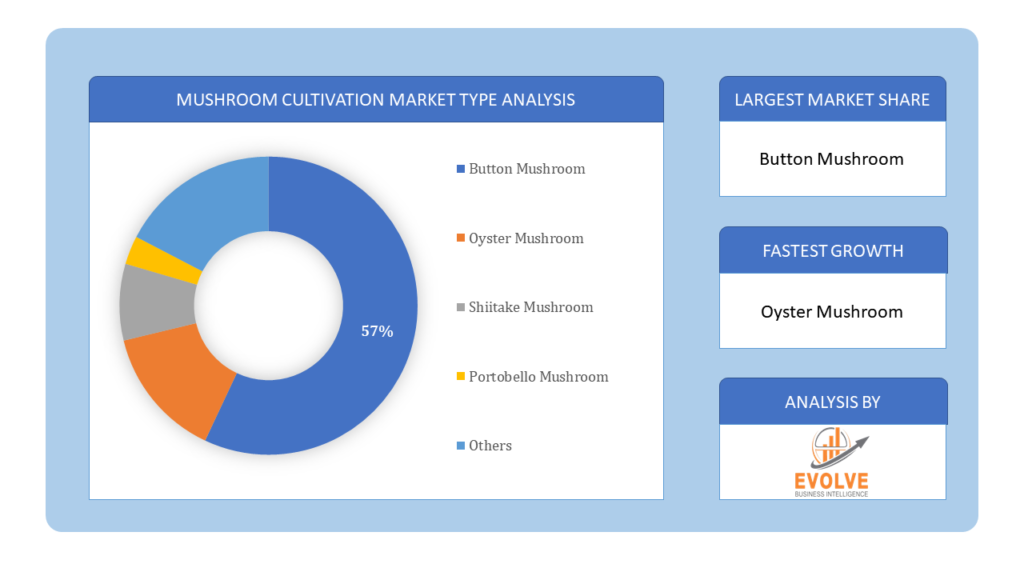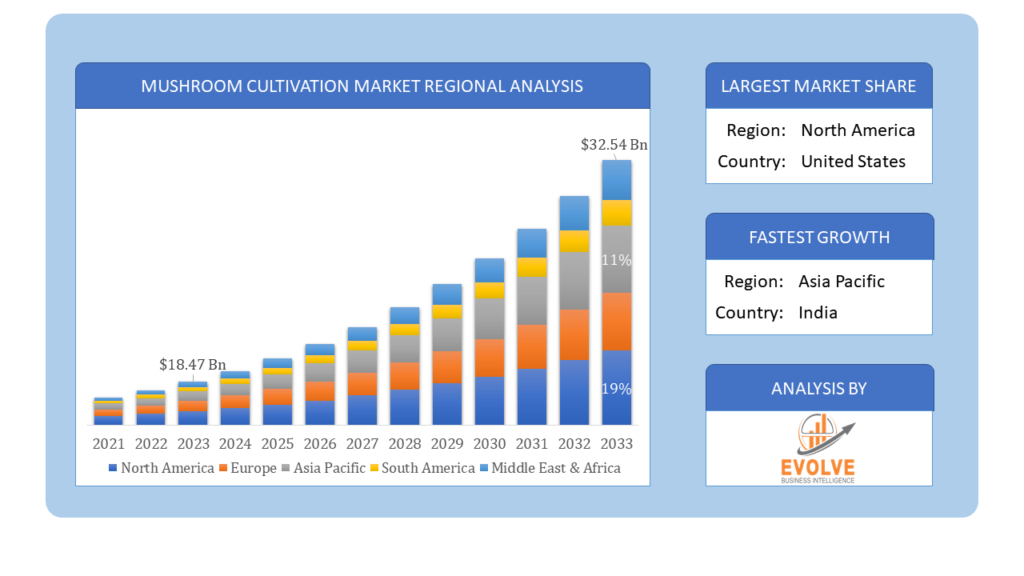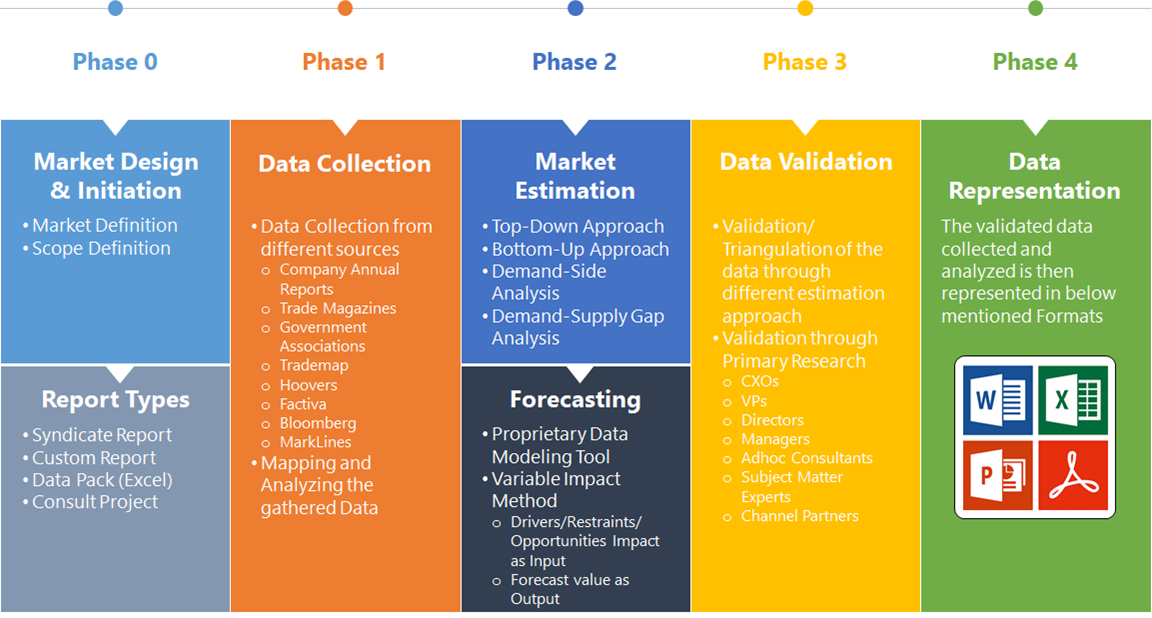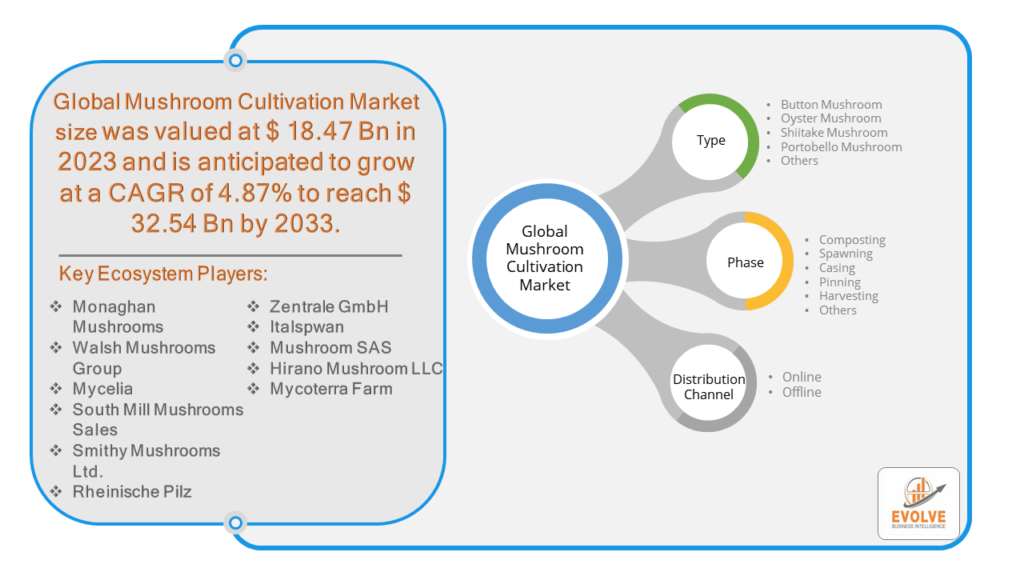Mushroom cultivation market Analysis and Global Forecast 2023-2033
$ 1,390.00 – $ 5,520.00
Mushroom cultivation market Research Report: Information By Type (Button Mushroom, Oyster Mushroom, Shiitake Mushroom, Portobello Mushroom, Others), By Phase (Composting, Spawning, Casing, Pinning, Harvesting, Others), By Sales Channel (Online, Offline), and by Region — Forecast till 2033
Page: 113
Mushroom cultivation market Overview
The Mushroom cultivation market Size is expected to reach USD 32.54 Billion by 2033. The Mushroom cultivation market industry size accounted for USD 18.47 Billion in 2023 and is expected to expand at a compound annual growth rate (CAGR) of 4.87% from 2023 to 2033. The mushroom cultivation market refers to the economic activity surrounding the controlled growing of edible mushrooms. This encompasses a variety of products and services that enable and support mushroom production, from spawn (the mushroom equivalent of seeds) to growing kits and sophisticated climate-controlled facilities.
The mushroom cultivation market is dynamic and evolving, driven by changing consumer trends, technological advancements, and innovations in cultivation techniques. It plays a significant role in the global food industry, providing a nutritious and versatile food source while also contributing to agricultural economies. The market is also seeing a growing trend of home-based mushroom cultivation, with an increasing number of companies offering mushroom growing kits for hobbyists and consumers.
Global Mushroom cultivation market Synopsis
The COVID-19 pandemic had several impacts on the mushroom cultivation market. During the early stages of the pandemic, lockdowns and restrictions on movement disrupted supply chains, leading to logistical challenges in transporting inputs such as spawn, substrate materials, and packaging materials to mushroom farms. This disruption affected the production capacity of mushroom growers. With changes in consumer behavior due to lockdowns, there was a shift in demand for mushrooms. While demand for fresh mushrooms initially decreased in some regions due to restaurant closures and reduced foodservice operations, there was an increase in demand for processed mushroom products such as canned and dried mushrooms, as consumers stocked up on shelf-stable food items. The pandemic prompted a heightened focus on health and wellness among consumers, leading to increased interest in immune-boosting foods like mushrooms. As a result, there may be long-term changes in consumer preferences towards mushrooms, creating opportunities for the mushroom cultivation market to capitalize on this trend.
Mushroom cultivation Market Dynamics
The major factors that have impacted the growth of Mushroom cultivation market are as follows:
Drivers:
Ø Growing Demand for Plant-Based Proteins
With rising awareness of sustainability and concerns about the environmental impact of meat production, there is a growing demand for plant-based protein sources. Mushrooms serve as a valuable meat substitute in vegetarian and vegan diets due to their umami flavor and meat-like texture, driving demand for mushroom cultivation. Advances in cultivation techniques, including indoor farming, controlled environment agriculture, and substrate optimization, have led to increased efficiency and productivity in mushroom cultivation. Technological innovations such as automated monitoring systems, climate control, and spawn development contribute to higher yields and quality, driving growth in the market. Mushrooms are not only consumed fresh but also processed into various food products such as soups, sauces, snacks, and meat alternatives. The expanding applications of mushrooms in the food industry, driven by culinary innovation and product development, contribute to market growth and diversification.
Restraint:
- Perception of Seasonal Variability
Although mushrooms can be cultivated throughout the year in controlled environments, outdoor cultivation is often subject to seasonal variability. Weather conditions such as temperature, humidity, and precipitation can impact outdoor mushroom production, leading to fluctuations in supply and pricing. Fresh mushrooms have a relatively short shelf life compared to other agricultural products and require proper storage conditions to maintain quality and prevent spoilage. Mushrooms are highly perishable and susceptible to deterioration, dehydration, and microbial contamination if not stored under controlled temperature and humidity conditions. The need for efficient storage facilities and transportation logistics adds complexity and cost to the supply chain.
Opportunity:
⮚ Rising Demand for Functional Foods
Mushrooms are increasingly recognized for their functional properties, including immune-boosting, antioxidant, and anti-inflammatory effects. As consumers become more health-conscious and seek out functional foods to support overall wellness, there is a growing opportunity to promote mushrooms as a nutritious addition to the diet. Developing innovative mushroom-based products, such as functional beverages, supplements, and snacks, could tap into this emerging market segment. Mushroom cultivation is inherently sustainable, as it utilizes agricultural by-products such as straw, sawdust, and agricultural waste as substrates. Promoting mushroom cultivation as a sustainable agricultural practice aligns with increasing consumer demand for environmentally friendly food options. Emphasizing the eco-friendly credentials of mushroom production could attract environmentally conscious consumers and enhance market competitiveness.
Mushroom cultivation market Segment Overview
By Type
 Based on Type, the market is segmented based on Button Mushroom, Oyster Mushroom, Shiitake Mushroom, Portobello Mushroom and Others. The Button Mushroom dominating the global mushroom cultivation market. This can be attributed to its exceptional nutritional profile, versatility in various cuisines, and wide acceptance across the globe. With its rich content of essential vitamins, minerals, and antioxidants, the Button Mushroom has gained significant popularity in the health and wellness industry, catering to the ever-growing demand for nutritious and functional food options.
Based on Type, the market is segmented based on Button Mushroom, Oyster Mushroom, Shiitake Mushroom, Portobello Mushroom and Others. The Button Mushroom dominating the global mushroom cultivation market. This can be attributed to its exceptional nutritional profile, versatility in various cuisines, and wide acceptance across the globe. With its rich content of essential vitamins, minerals, and antioxidants, the Button Mushroom has gained significant popularity in the health and wellness industry, catering to the ever-growing demand for nutritious and functional food options.
By Phase
Based on Phase, the market segment has been divided into Composting, Spawning, Casing, Pinning, Harvesting and Others. Composting is the initial stage where organic materials such as agricultural waste, straw, or manure are mixed and prepared to create a nutrient-rich substrate for mushroom growth. This substrate undergoes a controlled decomposition process, often involving heat treatment to eliminate pathogens and create optimal conditions for mushroom mycelium colonization.
By Sales Channel
Based on Sales Channel, the market segment has been divided into Online and Offline. The Offline segment is dominant the largest market. As these large retail outlets offer a wide variety of product under one roof, making them convenient shopping destination for consumer seeking mushroom and related products. Shoppers can find fresh and packed mushrooms, mushrooms based processed foods and etc all in one place.
Global Mushroom cultivation market Regional Analysis
Based on region, the global Mushroom cultivation market has been divided into North America, Europe, Asia-Pacific, the Middle East & Africa, and Latin America. North America is projected to dominate the use of the Mushroom cultivation market followed by the Asia-Pacific and Europe regions.
 Mushroom cultivation North America Market
Mushroom cultivation North America Market
North America holds a dominant position in the Mushroom cultivation market. The United States and Canada are major producers and consumers of cultivated mushrooms. Demand for organic and locally grown mushrooms is increasing, driven by health-conscious consumers and the farm-to-table movement. Technological advancements in indoor farming and controlled environment agriculture contribute to year-round production and consistent quality.
Mushroom cultivation Asia-Pacific Market
The Asia-Pacific region has indeed emerged as the fastest-growing market for the Mushroom cultivation market industry. China is the largest producer and consumer of mushrooms globally, with a wide variety of species cultivated, including shiitake, oyster, enoki, and wood ear mushrooms. Mushrooms are integral to Asian cuisines and traditional medicine, driving domestic consumption and export demand. Rapid urbanization, rising disposable incomes, and changing dietary habits contribute to growing demand for mushrooms as a healthy and versatile food option.
Competitive Landscape
The global Mushroom cultivation market is highly competitive, with numerous players offering a wide range of software solutions. The competitive landscape is characterized by the presence of established companies, as well as emerging startups and niche players. To increase their market position and attract a wide consumer base, the businesses are employing various strategies, such as product launches, and strategic alliances.
Prominent Players:
- Monaghan Mushrooms
- Walsh Mushrooms Group
- Mycelia
- South Mill Mushrooms Sales
- Smithy Mushrooms Ltd.
- Rheinische Pilz Zentrale GmbH
- Italspwan
- Mushroom SAS
- Hirano Mushroom LLC
- Mycoterra Farm
Scope of the Report
Global Mushroom cultivation Market, by Type
- Button Mushroom
- Oyster Mushroom
- Shiitake Mushroom
- Portobello Mushroom
- Others
Global Mushroom cultivation market, by Phase
- Composting
- Spawning
- Casing
- Pinning
- Harvesting
- Others
Global Mushroom cultivation market, by Sales Channel
- Online
- Offline
Global Mushroom cultivation market, by Region
- North America
- US
- Canada
- Mexico
- Europe
- UK
- Germany
- France
- Italy
- Spain
- Benelux
- Nordic
- Rest of Europe
- Asia Pacific
- China
- Japan
- South Korea
- Indonesia
- Austalia
- Malaysia
- India
- Rest of Asia Pacific
- South America
- Brazil
- Argentina
- Rest of SouthAmerica
- Middle East &Africa
- Saudi Arabia
- UAE
- Egypt
- SouthAfrica
- Rest of Middle East & Africa
| Parameters | Indicators |
|---|---|
| Market Size | 2033: $32.54 Billion |
| CAGR | 4.87% CAGR (2023-2033) |
| Base year | 2022 |
| Forecast Period | 2023-2033 |
| Historical Data | 2021 |
| Report Coverage | Revenue Forecast, Competitive Landscape, Growth Factors, and Trends |
| Key Segmentations | Type, Phase, Sales Channel |
| Geographies Covered | North America, Europe, Asia-Pacific, Latin America, Middle East, Africa |
| Key Vendors | Monaghan Mushrooms, Walsh Mushrooms Group, Mycelia, South Mill Mushrooms Sales, Smithy Mushrooms Ltd., Rheinische Pilz Zentrale GmbH, Italspwan, Mushroom SAS, Hirano Mushroom LLC and Mycoterra Farm. |
| Key Market Opportunities | • Rising Demand for Functional Foods • Sustainable Agriculture Practices |
| Key Market Drivers | • Growing Demand for Plant-Based Proteins • Technological Advancements in Cultivation |
REPORT CONTENT BRIEF:
- High-level analysis of the current and future Mushroom cultivation market trends and opportunities
- Detailed analysis of current market drivers, restraining factors, and opportunities in the future
- Mushroom cultivation market historical market size for the year 2021, and forecast from 2023 to 2033
- Mushroom cultivation market share analysis at each product level
- Competitor analysis with detailed insight into its product segment, Government & Defense strength, and strategies adopted.
- Identifies key strategies adopted including product launches and developments, mergers and acquisitions, joint ventures, collaborations, and partnerships as well as funding taken and investment done, among others.
- To identify and understand the various factors involved in the global Mushroom cultivation market affected by the pandemic
- To provide a detailed insight into the major companies operating in the market. The profiling will include the Government & Defense health of the company’s past 2-3 years with segmental and regional revenue breakup, product offering, recent developments, SWOT analysis, and key strategies.
Press Release

Glue Stick Market to Reach USD 2.35 Billion by 2034

Podiatry Service Market to Reach USD 11.88 Billion by 2034

Microfluidics Technology Market to Reach USD 32.58 Billion by 2034

Ferric Chloride Market to Reach USD 10.65 Billion by 2034

Family Practice EMR Software Market to Reach USD 21.52 Billion by 2034

Electric Hairbrush Market to Reach USD 15.95 Billion by 2034

Daily Bamboo Products Market to Reach USD 143.52 Billion by 2034

Cross-border E-commerce Logistics Market to Reach USD 112.65 Billion by 2034

Basic Silicone Market to Reach USD 28.74 Billion by 2034

Active Insulation Market to Reach USD 5.88 Billion by 2034
Frequently Asked Questions (FAQ)
What is the study period of the Mushroom cultivation market?
The study period spans from historical data in 2021 to forecasts for market trends from 2023 to 2033.
What is the growth rate of the Mushroom cultivation market?
The Mushroom cultivation market is expected to expand at a compound annual growth rate (CAGR) of 4.87% from 2023 to 2033.
Which region has the highest growth rate in the Mushroom cultivation market?
The Asia-Pacific region demonstrates the highest growth rate in the Mushroom cultivation market, driven by factors such as rapid urbanization, rising disposable incomes, and changing dietary habits.
Which region has the largest share of the Mushroom cultivation market?
North America is projected to dominate the Mushroom cultivation market, fueled by technological advancements in indoor farming and controlled environment agriculture.
Who are the key players in the Mushroom cultivation market?
Key players in the Mushroom cultivation market include Monaghan Mushrooms, Walsh Mushrooms Group, Mycelia, South Mill Mushrooms Sales, Smithy Mushrooms Ltd., Rheinische Pilz Zentrale GmbH, Italspwan, Mushroom SAS, Hirano Mushroom LLC, and Mycoterra Farm.
Do you offer Post Sale Support?
Yes, we offer 16 hours of analyst support to solve the queries
Do you sell particular sections of a report?
Yes, we provide regional as well as country-level reports. Other than this we also provide a sectional report. Please get in contact with our sales representatives.
Table of Content
CHAPTER 1. Executive Summary CHAPTER 2. Scope of the Study 2.1. Market Definition 2.2. Market Scope & Segmentation 2.2.1. Objective of Report CHAPTER 3. Evolve BI Methodology 3.1. Data Collection & Validation Approach 3.2. Market Size Estimation and Forecast CHAPTER 4. Exclusive Analysis 4.1. Market Opportunity Score 4.1.1. Type Segement – Market Opportunity Score 4.1.2. Phase Segment – Market Opportunity Score 4.1.3. Sales Channel Segment – Market Opportunity Score 4.2. Key Market Influencing Indicators CHAPTER 5. Market Insights and Trends 5.1. Value Chain Analysis 5.1.1. Raw Material 5.1.2. Manufacturing Process 5.1.3. Distribution Channel 5.1.4. End User 5.2. Porter’s Five Forces Analysis 5.2.1. Bargaining Power of Buyers 5.2.2. Bargaining Power of Suppliers 5.2.3. Threat of New Entrant 5.2.4. Threat of Substitute 5.2.5. Industry Rivalry 5.3. COVID-19 Impact and Post COVID Scenario on Mushroom cultivation market 5.3.1. Impact of COVID-19 5.3.2. Government Support and Industry Revival Policies 5.3.3. Measures Taken by Companies to Mitigate Negative Impact 5.3.4. Post COVID Trend CHAPTER 6. MArket Dynamics 6.1. Introduction 6.2. Drivers 6.2.1. Driver 1 6.2.2. Driver 2 6.2.3. Driver 3 6.3. Restraints 6.3.1. Restraint 1 6.3.2. Restraint 2 6.4. Opportunity 6.4.1. Opportunity 1 CHAPTER 7. Global Mushroom cultivation market, By Type 7.1. Introduction 7.1.1. Button Mushroom 7.1.2. Oyster Mushroom 7.1.3. Shiitake Mushroom 7.1.4. Portobello Mushroom 7.1.11. Other CHAPTER 8. Global Mushroom cultivation market, By Phase 8.1. Introduction 8.1.1. Composting 8.1.2. Spawning 8.1.3. Casing 8.1.4. Pinning 8.1.5. Harvesting 8.1.6. Others CHAPTER 9. Global Mushroom cultivation market, By Sales Channel 9.1. Introduction 9.1.1. Online 9.1.2. Offline CHAPTER 10. Global Mushroom cultivation market, By Region 10.1. Introduction 10.2. NORTH AMERICA 10.2.1. North America: Market Size and Forecast, By Country, 2023 – 2033 ($ Million) 10.2.2. North America: Market Size and Forecast, By Type, 2023 – 2033 ($ Million) 10.2.3. North America: Market Size and Forecast, By Phase, 2023 – 2033 ($ Million) 10.2.4. North America: Market Size and Forecast, By Sales Channel, 2023 – 2033 ($ Million) 10.2.5. US 10.2.5.1. US: Market Size and Forecast, By Type, 2023 – 2033 ($ Million) 10.2.5.2. US: Market Size and Forecast, By Phase, 2023 – 2033 ($ Million) 10.2.5.3. US: Market Size and Forecast, By Sales Channel, 2023 – 2033 ($ Million) 10.2.6. CANADA 10.2.6.1. Canada: Market Size and Forecast, By Type, 2023 – 2033 ($ Million) 10.2.6.2. Canada: Market Size and Forecast, By Phase, 2023 – 2033 ($ Million) 10.2.6.3. Canada: Market Size and Forecast, By Sales Channel, 2023 – 2033 ($ Million) 10.2.7. MEXICO 10.2.7.1. Mexico: Market Size and Forecast, By Type, 2023 – 2033 ($ Million) 10.2.7.2. Mexico: Market Size and Forecast, By Phase, 2023 – 2033 ($ Million) 10.2.7.3. Mexico: Market Size and Forecast, By Sales Channel, 2023 – 2033 ($ Million) 10.3. Europe 10.3.1. Europe: Market Size and Forecast, By Country, 2023 – 2033 ($ Million) 10.3.2. Europe: Market Size and Forecast, By Type, 2023 – 2033 ($ Million) 10.3.3. Europe: Market Size and Forecast, By Phase, 2023 – 2033 ($ Million) 10.3.4. Europe: Market Size and Forecast, By Sales Channel, 2023 – 2033 ($ Million) 10.3.5. U.K. 10.3.5.1. U.K.: Market Size and Forecast, By Type, 2023 – 2033 ($ Million) 10.3.5.2. U.K.: Market Size and Forecast, By Phase, 2023 – 2033 ($ Million) 10.3.5.3. U.K.: Market Size and Forecast, By Sales Channel, 2023 – 2033 ($ Million) 10.3.6. GERMANY 10.3.6.1. Germany: Market Size and Forecast, By Type, 2023 – 2033 ($ Million) 10.3.6.2. Germany: Market Size and Forecast, By Phase, 2023 – 2033 ($ Million) 10.3.6.3. Germany: Market Size and Forecast, By Sales Channel, 2023 – 2033 ($ Million) 10.3.7. FRANCE 10.3.7.1. France: Market Size and Forecast, By Type, 2023 – 2033 ($ Million) 10.3.7.2. France: Market Size and Forecast, By Phase, 2023 – 2033 ($ Million) 10.3.7.3. France: Market Size and Forecast, By Sales Channel, 2023 – 2033 ($ Million) 10.3.8. ITALY 10.3.8.1. Italy: Market Size and Forecast, By Type, 2023 – 2033 ($ Million) 10.3.8.2. Italy: Market Size and Forecast, By Phase, 2023 – 2033 ($ Million) 10.3.8.3. Italy: Market Size and Forecast, By Sales Channel, 2023 – 2033 ($ Million) 10.3.9. SPAIN 10.3.9.1. Spain: Market Size and Forecast, By Type, 2023 – 2033 ($ Million) 10.3.9.2. Spain: Market Size and Forecast, By Phase, 2023 – 2033 ($ Million) 10.3.9.3. Spain: Market Size and Forecast, By Sales Channel, 2023 – 2033 ($ Million) 10.3.10. BENELUX 10.3.10.1. BeNeLux: Market Size and Forecast, By Type, 2023 – 2033 ($ Million) 10.3.10.2. BeNeLux: Market Size and Forecast, By Phase, 2023 – 2033 ($ Million) 10.3.10.3. BeNeLux: Market Size and Forecast, By Sales Channel, 2023 – 2033 ($ Million) 10.3.11. RUSSIA 10.3.11.1. Russia: Market Size and Forecast, By Type, 2023 – 2033 ($ Million) 10.3.11.2. Russia: Market Size and Forecast, By Phase, 2023 – 2033 ($ Million) 10.3.11.3. Russia: Market Size and Forecast, By Sales Channel, 2023 – 2033 ($ Million) 10.3.12. REST OF EUROPE 10.3.12.1. Rest of Europe: Market Size and Forecast, By Type, 2023 – 2033 ($ Million) 10.3.12.2. Rest of Europe: Market Size and Forecast, By Phase, 2023 – 2033 ($ Million) 10.3.12.3. Rest of Europe: Market Size and Forecast, By Sales Channel, 2023 – 2033 ($ Million) 10.4. Asia Pacific 10.4.1. Asia Pacific: Market Size and Forecast, By Country, 2023 – 2033 ($ Million) 10.4.2. Asia Pacific: Market Size and Forecast, By Type, 2023 – 2033 ($ Million) 10.4.3. Asia Pacific: Market Size and Forecast, By Phase, 2023 – 2033 ($ Million) 10.4.4. Asia Pacific: Market Size and Forecast, By Sales Channel, 2023 – 2033 ($ Million) 10.4.5. CHINA 10.4.5.1. China: Market Size and Forecast, By Type, 2023 – 2033 ($ Million) 10.4.5.2. China: Market Size and Forecast, By Phase, 2023 – 2033 ($ Million) 10.4.5.3. China: Market Size and Forecast, By Sales Channel, 2023 – 2033 ($ Million) 10.4.6. JAPAN 10.4.6.1. Japan: Market Size and Forecast, By Type, 2023 – 2033 ($ Million) 10.4.6.2. Japan: Market Size and Forecast, By Phase, 2023 – 2033 ($ Million) 10.4.6.3. Japan: Market Size and Forecast, By Sales Channel, 2023 – 2033 ($ Million) 10.4.7. INDIA 10.4.7.1. India: Market Size and Forecast, By Type, 2023 – 2033 ($ Million) 10.4.7.2. India: Market Size and Forecast, By Phase, 2023 – 2033 ($ Million) 10.4.7.3. India: Market Size and Forecast, By Sales Channel, 2023 – 2033 ($ Million) 10.4.8. SOUTH KOREA 10.4.8.1. South Korea: Market Size and Forecast, By Type, 2023 – 2033 ($ Million) 10.4.8.2. South Korea: Market Size and Forecast, By Phase, 2023 – 2033 ($ Million) 10.4.8.3. South Korea: Market Size and Forecast, By Sales Channel, 2023 – 2033 ($ Million) 10.4.9. THAILAND 10.4.9.1. Thailand: Market Size and Forecast, By Type, 2023 – 2033 ($ Million) 10.4.9.2. Thailand: Market Size and Forecast, By Phase, 2023 – 2033 ($ Million) 10.4.9.3. Thailand: Market Size and Forecast, By Sales Channel, 2023 – 2033 ($ Million) 10.4.10. INDONESIA 10.4.10.1. Indonesia: Market Size and Forecast, By Type, 2023 – 2033 ($ Million) 10.4.10.2. Indonesia: Market Size and Forecast, By Phase, 2023 – 2033 ($ Million) 10.4.10.3. Indonesia: Market Size and Forecast, By Sales Channel, 2023 – 2033 ($ Million) 10.4.11. MALAYSIA 10.4.11.1. Malaysia: Market Size and Forecast, By Type, 2023 – 2033 ($ Million) 10.4.11.2. Malaysia: Market Size and Forecast, By Phase, 2023 – 2033 ($ Million) 10.4.11.3. Malaysia: Market Size and Forecast, By Sales Channel, 2023 – 2033 ($ Million) 10.4.12. AUSTRALIA 10.4.12.1. Australia: Market Size and Forecast, By Type, 2023 – 2033 ($ Million) 10.4.12.2. Australia: Market Size and Forecast, By Phase, 2023 – 2033 ($ Million) 10.4.12.3. Australia: Market Size and Forecast, By Sales Channel, 2023 – 2033 ($ Million) 10.4.13. REST FO ASIA PACIFIC 10.4.13.1. Rest fo Asia Pacific: Market Size and Forecast, By Type, 2023 – 2033 ($ Million) 10.4.13.2. Rest fo Asia Pacific: Market Size and Forecast, By Phase, 2023 – 2033 ($ Million) 10.4.13.3. Rest fo Asia Pacific: Market Size and Forecast, By Sales Channel, 2023 – 2033 ($ Million) 10.5. South America 10.5.1. South America: Market Size and Forecast, By Country, 2023 – 2033 ($ Million) 10.5.2. South America: Market Size and Forecast, By Type, 2023 – 2033 ($ Million) 10.5.3. South America: Market Size and Forecast, By Phase, 2023 – 2033 ($ Million) 10.5.4. South America: Market Size and Forecast, By End-user, 2023 – 2033 ($ Million) 10.5.5. BRAZIL 10.5.5.1. Brazil: Market Size and Forecast, By Type, 2023 – 2033 ($ Million) 10.5.5.2. Brazil: Market Size and Forecast, By Phase, 2023 – 2033 ($ Million) 10.5.5.3. Brazil: Market Size and Forecast, By Sales Channel, 2023 – 2033 ($ Million) 10.5.6. ARGENTINA 10.5.6.1. Argentina: Market Size and Forecast, By Type, 2023 – 2033 ($ Million) 10.5.6.2. Argentina: Market Size and Forecast, By Phase, 2023 – 2033 ($ Million) 10.5.6.3. Argentina: Market Size and Forecast, By Sales Channel, 2023 – 2033 ($ Million) 10.5.7. REST OF SOUTH AMERICA 10.5.7.1. Rest of South America: Market Size and Forecast, By Type, 2023 – 2033 ($ Million) 10.5.7.2. Rest of South America: Market Size and Forecast, By Phase, 2023 – 2033 ($ Million) 10.5.7.3. Rest of South America: Market Size and Forecast, By Sales Channel, 2023 – 2033 ($ Million) 10.6. Middle East & Africa 10.6.1. Middle East & Africa: Market Size and Forecast, By Country, 2023 – 2033 ($ Million) 10.6.2. Middle East & Africa: Market Size and Forecast, By Type, 2023 – 2033 ($ Million) 10.6.3. Middle East & Africa: Market Size and Forecast, By Phase, 2023 – 2033 ($ Million) 10.6.4. Middle East & Africa: Market Size and Forecast, By Sales Channel, 2023 – 2033 ($ Million) 10.6.5. SAUDI ARABIA 10.6.5.1. Saudi Arabia: Market Size and Forecast, By Type, 2023 – 2033 ($ Million) 10.6.5.2. Saudi Arabia: Market Size and Forecast, By Phase, 2023 – 2033 ($ Million) 10.6.5.3. Saudi Arabia: Market Size and Forecast, By Sales Channel, 2023 – 2033 ($ Million) 10.6.6. UAE 10.6.6.1. UAE: Market Size and Forecast, By Type, 2023 – 2033 ($ Million) 10.6.6.2. UAE: Market Size and Forecast, By Phase, 2023 – 2033 ($ Million) 10.6.6.3. UAE: Market Size and Forecast, By Sales Channel, 2023 – 2033 ($ Million) 10.6.7. EGYPT 10.6.7.1. Egypt: Market Size and Forecast, By Type, 2023 – 2033 ($ Million) 10.6.7.2. Egypt: Market Size and Forecast, By Phase, 2023 – 2033 ($ Million) 10.6.7.3. Egypt: Market Size and Forecast, By Sales Channel, 2023 – 2033 ($ Million) 10.6.8. SOUTH AFRICA 10.6.8.1. South Africa: Market Size and Forecast, By Type, 2023 – 2033 ($ Million) 10.6.8.2. South Africa: Market Size and Forecast, By Phase, 2023 – 2033 ($ Million) 10.6.8.3. South Africa: Market Size and Forecast, By Sales Channel, 2023 – 2033 ($ Million) 10.6.9. REST OF MIDDLE EAST & AFRICA 10.6.9.1. Rest of Middle East & Africa: Market Size and Forecast, By Type, 2023 – 2033 ($ Million) 10.6.9.2. Rest of Middle East & Africa: Market Size and Forecast, By Phase, 2023 – 2033 ($ Million) 10.6.9.3. Rest of Middle East & Africa: Market Size and Forecast, By Sales Channel, 2023 – 2033 ($ Million) CHAPTER 12. Competitive Landscape 12.1. Competitior Benchmarking 2023 12.2. Market Share Analysis 12.3. Key Developments Analysis By Top 5 Companies 12.4. Market Share Acquisition Strategies: Analysis of Key Approaches Employed by Top Players CHAPTER 13. Company Profiles 13.1. Monaghan Mushrooms 13.1.1. Business Overview 13.1.2. Financial Analysis 13.1.2.1. Business Segment Revenue, 2020, 2021, 2022, $ Million 13.1.2.2. Geographic Revenue Mix, 2022 (% Share) 13.1.3. Product Portfolio 13.1.4. Recent Development and Strategies Adopted 13.1.5. SWOT Analysis 13.2. Walsh Mushrooms Group 13.3. Mycelia 13.4. South Mill Mushrooms Sales 13.5. Smithy Mushrooms Ltd. 13.6. Rheinische Pilz Zentrale GmbH 13.7. Italspwan 13.8. Mushroom SAS 13.9. Hirano Mushroom LLC 13.10. Mycoterra Farm
Connect to Analyst
Research Methodology





